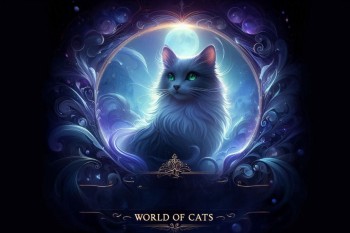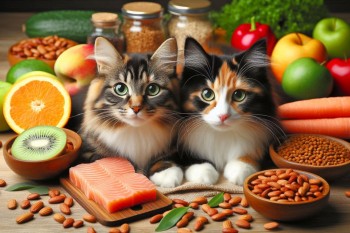10 Unheard Peculiarities of Feline Friends 🐱 | Exploring the Mysteries of Cats
Cats have been domesticated since ancient times
and share our homes as beloved pets. But even after thousands of years by our
side, felines still hold many mysteries. As a veterinarian, I'm constantly
learning new things about these enigmatic creatures. In this blog post, I'll
share 10 fascinating peculiarities about our feline friends that you may not
have heard before! Get ready to have your mind blown by how truly unique cats
are. 🤯
1. They Have a Jacobson's Organ
The Jacobson's organ is an extra sensory organ
located in the roof of a cat's mouth. It allows them to pick up pheromones and
other chemical cues from scents we can't detect. Cats use this organ by opening
their mouth and curling their upper lip when sniffing. This "flehmen
response" lets scent molecules enter the vomeronasal organ. So next time
you see kitty making a funny face, they're just gathering extra sensory
information!
2. They Can't Taste Sweets
It may be why cats aren't drawn to sugary treats
like dogs are. Their taste buds lack receptors for sweetness due to a genetic
defect. But while they can't taste the sweetness, cats can still detect the
texture and smell of sugary foods. So they enjoy a good cat-safe cake just as much as we do! Just no
candies which are toxic to cats.
3. They Have Floating Clavicle Bones
Unlike us humans, cats have a floating clavicle
bone that is not anchored to any other bone. This allows them to freely pass
their shoulders through narrow spaces and squeeze into tight spots. It
contributes to their incredible agility and flexibility. A cat's collarbone
also shifts position when climbing or jumping to stabilize the forelimbs.
Pretty neat trick for daredevil cats!
4. They are Digitigrades
Meaning they walk on their toes! Cats are
digitigrades, standing and moving with heel elevated and only the toes touching
the ground. Dogs by contrast are plantigrades, walking with their heels and
soles on the ground like humans. Being digitigrade gives cats a longer stride,
faster acceleration, ability to sneak up on prey and quietly move about. It's
the perfect adaptation for their predatory lifestyle.
5. They Have a Third Eyelid
That creepy membrane that flashes across a cat's
eye? It's called the third eyelid or nictitating membrane. All cats have this
extra eyelid to protect and lubricate their eyes. It sweeps horizontally across
the eye surface, removing debris and distributing tears. You'll notice it most
often when a cat is ill or falling asleep. If the membrane is consistently
visible, it could signal an eye injury or illness, so schedule a vet visit.
6. They See Ultraviolet Light
Humans have 3 color cone photoreceptors in our
eyes that allow us to see the colors of the rainbow. But cats have an
additional fourth cone that lets them see ultraviolet light! Their enhanced
vision includes seeing urine trails, hidden patterns on flowers and markings on
other animals. No wonder cats stare intently at seemingly empty spaces - they're
seeing things our inferior human eyes can't!
7. They Have Barbed Tongues
A cat's tongue feels like sandpaper for good
reason - it's covered in tiny hook-like barbs called papillae. These tiny
keratinous spines allow cats to groom themselves by scraping off dirt,
detangling fur, spreading saliva and stimulating blood circulation. A feline
tongue has over 300 papillae per square inch! Their rough
tongues also help cats scrape every last bite from bones at mealtime.
8. They are Polydactyl
Polydactyl cats have extra toes, usually on
their front paws. Normal cats have 5 toes on the front paws and 4 on the back.
But polydactyls can have as many as 9 toes on a front paw! The extra toes look
like little thumbs. Polydactylism is caused by a dominant genetic mutation and
more common in certain geographical areas, like Ernest Hemingway's famous
6-toed cats in Key West, Florida. The extra toes don't cause cats any problems.
9. They Can't Taste Water
Cats prefer running water because their
tastebuds can't detect still water very well. In the wild, standing water tends
to be contaminated or stagnant, while running water is safer. So while cats
will reluctantly drink from still bowls if thirsty, they strongly prefer fresh
running water. Consider adding a pet water fountain to entice your cat to drink
more!
10. They Have a Bifid Tongue Tip
Look closely at your cat's tongue - see the
split tip? This bifid or forked tongue is another clever cat adaptation. The
two tips allow cats to lap water more efficiently and groom difficult to reach
spots. The roughness of the twin tips also helps scrape meat from bone and
clean dirt from fur. Your cat's split tongue tip is perfectly designed for all
their grooming and dining needs!
Those are 10 fascinating feline peculiarities
you may not have known before! Cats are truly marvels of evolution with their specialized
organs, enhanced senses and unique physical adaptations. We've only begun to
unravel the mysteries of these majestic creatures. Learning more about our
enigmatic feline friends reveals just how special cats are. 😻
As your veterinarian, I hope this post gave you
some newfound appreciation for your cat's amazing abilities. If you have any
other questions about your cat's health or behavior, don't hesitate to call our
veterinary office. We're always happy to provide advice on keeping your feline friends
at their best! In the meantime, observe your own cat closely to see these
oddities in action.
To learn more about cats, check out these
resources:
·
How Cats See The World Differently - An
overview of cats' enhanced vision and senses.
·
Why Does My Cat Knead Me? - Insight into
cats' kneading and suckling behavior.
·
Do Cats Have Bones In Their Ears? -
Information on cats' flexible ear anatomy.
·
Why Is My Cat Meowing So Much? - Tips for
understanding your cat's vocalizations.
Stay tuned for more fun facts about our feline
friends! Let me know in the comments if you learned something new about cats
today. And please share this post if you found it interesting. Meow for now! 😸


















